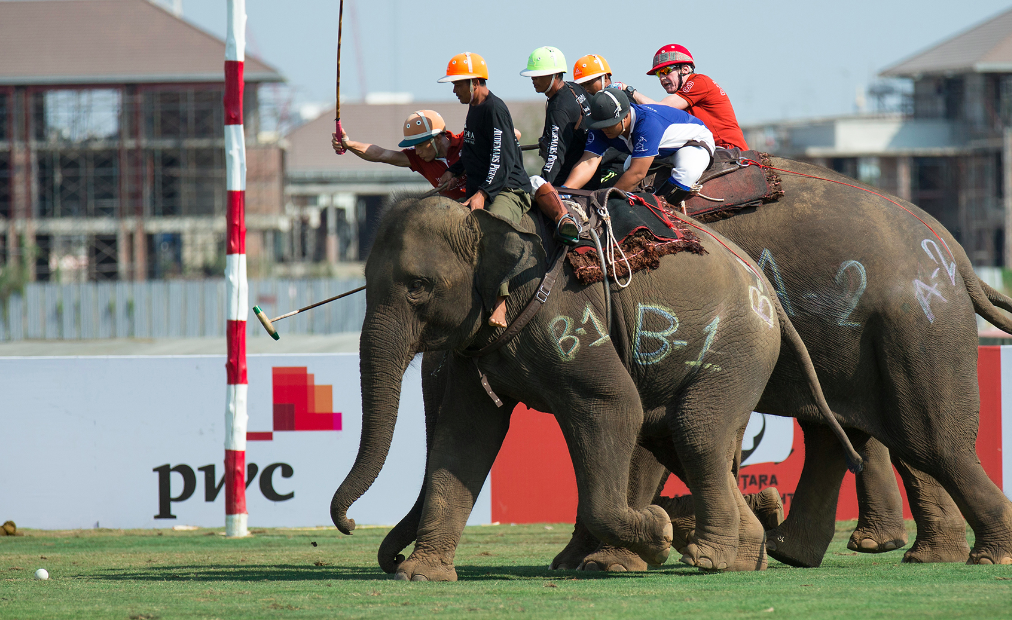From the shores of a Thailand resort town, a reporter explores what happens when you mix rich men, elephants, and polo gear
By Rolf Potts
On a palm-fringed playing field just outside the Thai resort town of Hua Hin, the semifinal of the King’s Cup Elephant Polo Tournament is underway: Two-ton beasts lumber around the pitch carrying pith-helmeted players, who whap at a tiny polo ball with 8-foot-long mallets. A gallery of bemused tourists and Thais chats amongst themselves at the edge of the field, pausing to clap politely whenever the ball manages to roll its way over the goal line.
I sit in the press box with my notepad and try to figure out how to describe the elephant polo action. It’s not easy. The rules are simple enough: two teams of three elephants each face off on a field slightly larger than a football pitch for two ten-minute “chukkas” of playing time; goals are scored when the ball rolls between the red-and-white poles at each end of the field. But, while the King’s Cup is an elite contest in the sport’s Triple Crown (annual tournaments are also played in Nepal and Sri Lanka), but it’s hard to get excited about a game that moves with all the intensity of slow-motion replay. In sporting terms, the spectacle is slightly more intense than croquet, yet somehow less engrossing than skeet shooting. Moreover, considering that none of the players know how to drive their own elephants (this task is left to Thai mahouts), specific skills and strategies can be difficult to pinpoint. Imagine a Grand Prix auto race full of school buses steered by giving verbal commands to Bangladeshi truck drivers, and you get a vague idea of elephant polo’s tactical challenges.
A gong rings out after ten minutes of play, signaling the end of the first chukka. The players retire to a VIP tent for Bloody Marys and cucumber sandwiches, the Thai mahouts squat to smoke cigarettes along the sidelines, and the elephants pad off to douse themselves with pond-water. Notebook in hand, I wander over to hang out with the elephants.
One of the aims of the King’s Cup is to raise money for Thailand’s National Elephant Institute, and on this day the animals are certainly earning their keep. In addition to serving as polo steeds, NEI elephants have been entertaining spectators by painting pictures with their trunks and pounding out music on oversized xylophones. Whimsical though this may sound, these elephantine pursuits have already caused a ripple on the international art scene: elephant paintings have been auctioned for thousands of dollars at Christie’s in London, and a CD of “Elephant Orchestra” music landed on the New York Times’ year-end “Best of the Obscure” list in 2001. A new CD, which includes elephant techno mixes and an MTV-style video, is planned for release next year.
Pop art aside, the National Elephant Institute is the legacy of a 1989 Thai logging ban that put hundreds of domesticated elephants and mahouts out of work. Since there was not enough native habitat left in Thailand to support these elephants in the wild, many were reduced to begging food with their trainers on the streets of Bangkok and Chiang Mai. According to Richard Lair, the drawling San Francisco exile who’s been working with Thai elephants for over a decade, the institute seeks to provide domesticated elephants the chance to “make a living” through tourist activities, the sale of paintings, and sponsored spectacles such as elephant polo.
“I’m not sure that the elephants care one way or another about playing the game,” Lair tells me as we wander through the elephant pavilion adjacent to the polo pitch. “I suppose the younger elephants enjoy running around, but they mostly see it as just another job to do.”
Of all the exhibits Lair has on display, I’m most fascinated by a booth illustrating how heavy-grade ornamental paper can be pressed from elephant dung (huge piles of which are removed from the playing field by Thai workers as the polo game progresses). When I express skepticism at the aesthetic appeal of paper that has passed through a two-ton pachyderm, Lair is unruffled.
“Elephant-dung paper is very popular with tourists,” he insists. “Although our experiment with elephant-dung hats wasn’t quite as successful.”
“Why, was it too hard to mold the paper?”
“Oh, the hats molded just fine,” Lair says, giving me a wry look. “They just didn’t hold up in the rain.”
As if on cue, the gong rings out, and another chukka of elephant polo begins.
That evening, I put on my finery and head out to the “Silk Road” elephant polo gala, which takes place along the landscaped lagoons of Hua Hin’s posh Anantara Resort. Here, the Gulf of Thailand beachfront has been transformed into something resembling a Central Asian bazaar: Chinese acrobats juggle and contort, colorful tents dispense Persian and Turkish delicacies, and (in a decidedly anomalous detail) a chubby Thai man sings pitch-perfect renditions of Louis Armstrong songs. In keeping with the Silk Road theme, the polo players have come dressed as Venetian merchants and Kazakh warlords.
Though I’ve been mingling with these players for nearly half a week, I’m still not sure what most of them do for a living. A few have referred to themselves as lawyers or real-estate men, but there seems to be an old-money vagueness to their professional pursuits. According to the press kit, a Scottish member of the Nepal team has spent time searching for the “lost treasures of the Inca”, an American player on Thailand’s squad has been flying a Cessna around Africa and Asia for the past 12 years, and the English captain of the Sri Lanka team once went to sea on a bamboo raft to prove that the Chinese reached America before Columbus.
At the edge of the banquet hall I recognize a tall, silk-clad gentleman as Jim Edwards, the sexagenarian Brit who (along with Scotsman James Manclark) dreamt up elephant polo over buttered rum at a St. Moritz toboggan club in 1982. Two decades on, his World Elephant Polo Association has grown to encompass three annual tournaments, a website that hawks official sportswear, and formal recognition by the Nepal Olympics Association (which gives elephant polo the distinction of being the first Olympic candidate-sport wherein dung from the gold-medal match can be fashioned into commemorative stationery).
“Technically, elephant polo was never our invention,” Edwards tells me, sipping at a gin-and-tonic. “An early form of the game was played in the 18th century, in the harems of the Mogul Indian kings; we’ve just revived that tradition and added modern rules. For those of us who love the game, elephant polo isn’t really a sport so much as a way of life.” He pauses to take in the Chinese acrobats and the sumptuous spread of the buffet tables. “It’s a jolly good excuse for a party as well.”
The acrobats soon make way for a gala auction of elephant paintings to benefit the Thai Elephant Institute. As cocktails are quaffed and the bidding heats up, I casually joke to the resort publicist that elephant polo will one day overtake golf as a status-sport for corporate bigwigs. Five minutes later, she returns with a brochure for Anantara’s “Elephant Polo Team-Building Programme” — a corporate-initiative spa package that includes three-to-a-side elephant polo matches, souvenir videotapes of the action, and trophies for the winners. As I page through the brochure, a Swedish member of the Nepal team leaps up onto the stage, strips off his dirty polo socks and — in a gin-fueled moment of inspiration — triumphantly auctions them off for $1000.
By the end of the night, the elephants of Thailand are $25,000 richer, and a good number of the players are walking around barefoot.
The championship game takes place the following day, as the defending champion Chivas Regal Nepal team takes the field against an upstart trio of Mercedes-sponsored Germans. Since the press section is full, I sit with a team of cheerful Australian and Canadian expatriates who’ve been playing under the flag of Singapore. By far the most plebian of the King’s Cup competitors, the Singapore team has managed to win the approval of the other players with their boisterous charm, their impeccable sportsmanship, and their hapless tendency to lose every game they play.
“We held most of our team practices in a pub,” Singapore captain Tim Deyzel admits as we watch the Germans lumber off to an early lead. “But we’re thinking about buying a ladder for next year.”
“A ladder?”
“For practice.” Deyzel gives me a sober look. “It’s hard to find elephants in Singapore.”
As the championship game plods on, I joke with the Singapore players about what could be done to perk up such an inherently slow-paced game. Elephant cheerleaders, perhaps? Steroids? Brawls? A three-point line? Celebrity dung-pickers?
My answer comes in the midst of the second chukka, when a freak thunderstorm breaks out and the pace of the game mysteriously picks up. Peering into the deluge, I can’t immediately pinpoint the source of this new vitality, since the mahouts appear disoriented, the players look sodden and miserable, and the ball keeps disappearing into mud puddles. Then, amidst the raindrops, I notice certain spring in the step of the animals that have carried this whole crazy tournament on their backs.
Indeed, after four days on the job, is appears as if the elephants have finally found reason to enjoy themselves.
[This essay originally appeared in the January 2004 issue of Conde Nast Traveler.]






